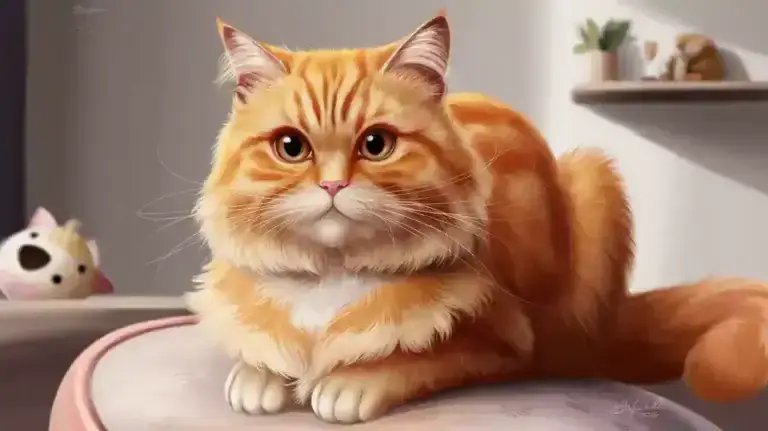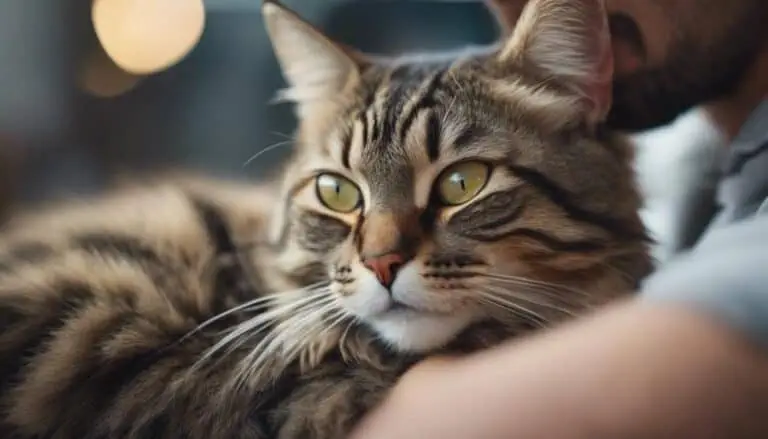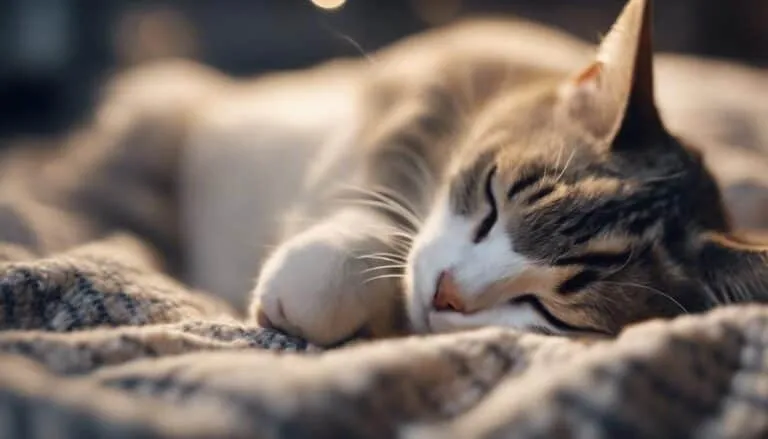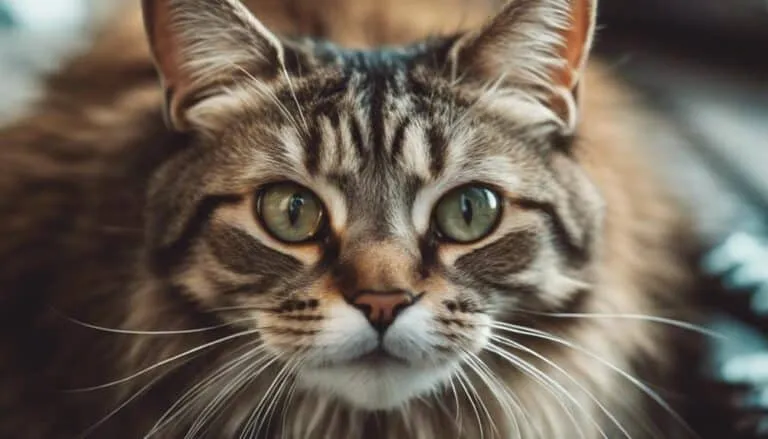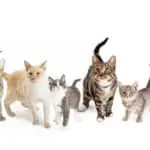The Best Fluffy Pancakes recipe you will fall in love with. Full of tips and tricks to help you make the best pancakes.

The enigmatic behavior of purring in cats has captivated the curiosity of scientists and pet owners alike. While it is widely known that cats use purring as a means of communication, the true meaning behind this mysterious behavior remains elusive.
In this discussion, we will explore the depths of feline communication, examining the various types of purrs and their corresponding emotions. By unraveling the intricacies of purring, we will gain a deeper understanding of the unique ways in which cats express themselves.
So, join us on this journey as we unravel the secrets of purring and uncover what cats really communicate.
Key Takeaways
- Kittens begin to purr at around three weeks of age as a way to communicate with their mother for milk.
- Cats purr to express happiness and contentment, but it can also be a sign of hunger or pain.
- Purring helps cats bond with their mother and siblings and can aid in their healing process.
- Cats use meowing to communicate with humans, while purring is used for both humans and other cats.
The Development of Purring
The development of purring in cats is a crucial milestone in their early development, serving as a vital form of communication with their mother and siblings. Purring is an instinctive behavior that begins at a young age, typically around three weeks old. This gentle rumbling sound is produced by the vibrations of the cat's vocal cords and is used to communicate various needs and emotions.
Interestingly, different cat breeds may have their own unique purring styles. Some purrs are soft and subtle, while others are more pronounced and loud. These variations in purring can provide valuable insights into a cat's breed and personality.
Purring also plays a significant role in social interactions among cats. It helps to establish and strengthen bonds between mother cats and their kittens. Kittens often purr to signal their contentment and to ask for attention or food. Purring can also be a form of self-soothing, helping cats to relax and cope with stressful situations.
The Meaning Behind Purring
Understanding the true meaning behind a cat's purring can provide valuable insights into their emotional state and communication needs. Purring serves as a significant form of communication for cats, as it plays a crucial role in social bonding. When a cat purrs, it signals a sense of comfort, contentment, and security. It is a way for them to express their happiness and satisfaction with their environment and the people or animals around them.
Purring also helps cats establish and maintain social connections with their littermates, mother, and even their human companions. It creates a sense of trust and strengthens the bond between individuals. Therefore, paying attention to a cat's purring can help us better understand their emotional well-being and cater to their communication needs, fostering a deeper connection with our feline friends.
Purring as a Healing Mechanism
Purring, a natural instinct in cats, has been observed to have potential healing benefits for felines. When a cat purrs, it not only communicates its contentment but also triggers physiological effects that aid in healing.
The healing benefits of purring include:
- Pain reduction: Purring releases endorphins, natural painkillers that help alleviate discomfort and promote healing.
- Stress reduction: The rhythmic vibrations produced during purring have a calming effect on cats, reducing stress and anxiety that can hinder the healing process.
- Bone and tissue regeneration: The frequency of a cat's purring, ranging from 25 to 150 Hertz, has been found to promote bone density and tissue repair.
Understanding the physiological effects of purring allows us to appreciate how cats instinctively use this mechanism to heal themselves. By recognizing and nurturing their purring behavior, we can support our feline companions in their journey towards optimal health and well-being.
The Various Types of Purring
As we continue to explore the fascinating world of cat communication, it becomes evident that understanding the different types of purring is crucial in deciphering the intricate language of our feline companions.
Purring is a physiological process that involves the rapid contraction and relaxation of the muscles in a cat's larynx and diaphragm. It is a complex behavior that serves various evolutionary purposes.
While we often associate purring with contentment and relaxation, it can also serve as a means of communication for cats. Different types of purring can indicate different emotions and needs.
For example, a deep, rumbling purr may signify happiness and relaxation, while a higher-pitched purr may be a sign of hunger or excitement.
Meowing: A Unique Behavior
Meowing, a behavior exclusive to humans, is a unique form of communication that cats utilize to interact with their human companions. This vocalization has evolved over time, adapting to the needs of domesticated cats. Meowing serves several important roles in cat-human relationships.
Evolution of meowing: Through domestication, cats have developed meowing as a way to communicate with humans. This behavior allows them to express their needs and desires, as well as seek attention and companionship.
Role of meowing in cat-human relationships: Meowing plays a crucial role in strengthening the bond between cats and their human companions. By meowing, cats can convey their emotions, request food or access to certain areas, and even engage in social interactions. This unique form of communication enhances understanding and facilitates a deeper connection between cats and their owners.
Understanding the significance of meowing enables us to better serve our feline friends, ensuring their well-being and happiness.
Meowing to Communicate Needs
Cats utilize meowing as a means to effectively communicate their needs and desires to their human companions.
When a cat meows, it can be a way of seeking attention or expressing a need for affection.
Whether they want to be petted, played with, or simply acknowledged, meowing is their way of getting their human's attention.
Sometimes, a cat may meow persistently to convey their longing for affection and companionship.
It is important for cat owners to pay attention to these vocalizations and respond accordingly.
By understanding the different tones and contexts of their meows, humans can better serve their feline companions and strengthen the bond they share.
The Universality of Purring
Understanding the various ways in which cats communicate, including through meowing, allows us to delve deeper into the universality of purring.
Purring is a form of communication that transcends cultural differences in cat purring. Whether they are domestic cats or wild cats, purring is a universal behavior that is exhibited by different cat species.
It is a way for cats to express their emotions, such as contentment, relaxation, or even pain. Purring is not exclusive to humans; it is a means for cats to communicate with each other and themselves.
Despite the differences in their environments and upbringing, cats from different cultures and species all share this common form of communication.
Understanding the universality of purring can help us build stronger connections with our feline companions and provide better care for them.
Decoding a Cat's Purring
Deciphering the subtle nuances of a cat's purring can provide valuable insights into their emotions and needs. Purring is not only a sign of contentment but also serves as a means of communication between cats and humans.
Understanding the role of purring in cat socialization is crucial in strengthening the human-cat bond. When a cat purrs, it not only expresses its happiness but also seeks reassurance and comfort from its human companion. This empathetic exchange can have a profound impact on human stress levels.
Research has shown that the soothing vibrations of a cat's purring can help reduce stress, lower blood pressure, and promote relaxation. By decoding a cat's purring, we can better serve their emotional needs and cultivate a harmonious relationship with our feline friends.
Understanding Cat Body Language
Interpreting the subtle cues of a cat's body language is essential in unraveling the intricate tapestry of feline communication. Cats use their bodies to express their emotions, needs, and desires. By understanding their body language, we can better understand and respond to their needs.
Here are some key points to consider when interpreting feline body language:
- Pay attention to their tail: A relaxed and upright tail usually indicates a content and confident cat. A puffed-up or tucked-under tail, on the other hand, can be a sign of fear or discomfort.
- Watch their ears: Forward-facing and perked-up ears often indicate curiosity and attentiveness. Flattened or backward-facing ears, however, can signify aggression, fear, or stress.
- Notice their body posture: A relaxed and open posture suggests a calm and comfortable cat. On the contrary, a hunched or crouched posture may signal fear or pain.
Recognizing signs of discomfort in cats is crucial for their well-being. By observing their body language, we can provide them with the care and support they need.
Strengthening the Human-Cat Bond
Fostering a strong and meaningful connection between humans and their feline companions requires patience, dedication, and a deep understanding of their unique needs and behaviors.
Strengthening the human-cat bond is a two-way process that involves decoding cat emotions and responding appropriately. Cats communicate through a variety of means, including body language, vocalizations, and purring. By observing and interpreting these signals, humans can better understand their cat's emotions and needs.
This understanding allows for a more empathetic and responsive approach to caregiving. Spending quality time together, providing a safe and stimulating environment, and meeting their physical and emotional needs are crucial in building trust and strengthening the bond.
Conclusion
In conclusion, delving into the mysterious world of purring has allowed us to gain a deeper understanding of the intricate communication of our feline companions. By decoding the different types of purrs and understanding cat body language, we can strengthen our bond with these beloved pets.
Purring serves as a healing mechanism and a means of expressing various emotions. Through intuitive and empathetic observation, we can unlock the true meaning behind a cat's purring, enhancing their overall welfare and our human-cat relationship.

